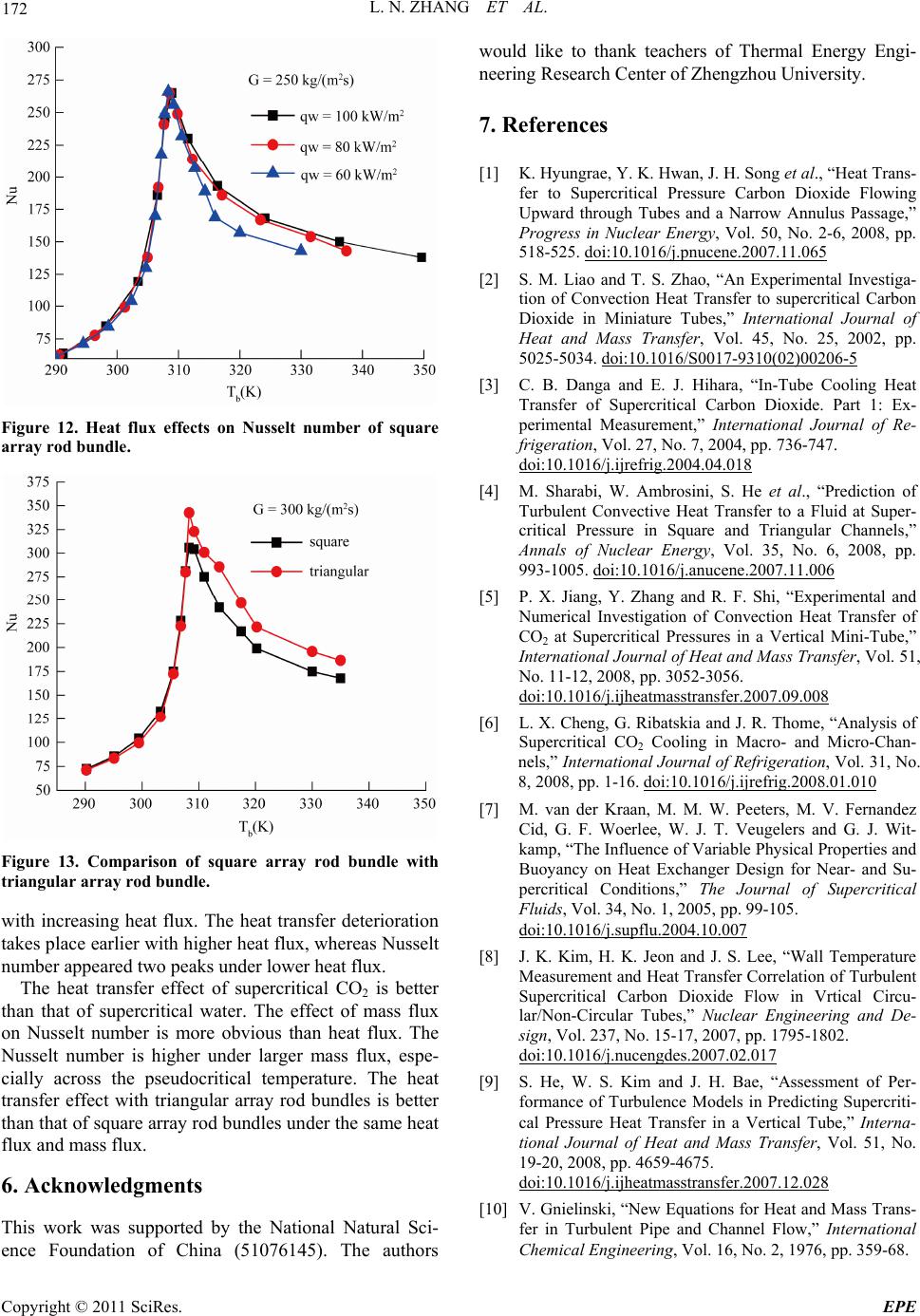
172 L. N. ZHANG ET AL.
Figure 12. Heat flux effects on Nusselt number of square
array rod bundle.
Figure 13. Comparison of square array rod bundle with
triangular array rod bundle.
with increasing heat flux. The heat transfer deterioration
takes place earlier with higher heat flux, whereas Nusselt
number appeared two peaks under lower heat flux.
The heat transfer effect of supercritical CO2 is better
than that of supercritical water. The effect of mass flux
on Nusselt number is more obvious than heat flux. The
Nusselt number is higher under larger mass flux, espe-
cially across the pseudocritical temperature. The heat
transfer effect with triangular array rod bundles is better
than that of square array rod bundles under the same heat
flux and mass flux.
6. Acknowledgments
This work was supported by the National Natural Sci-
ence Foundation of China (51076145). The authors
would like to thank teachers of Thermal Energy Engi-
neering Research Center of Zhengzhou University.
7. References
[1] K. Hyungrae, Y. K. Hwan, J. H. Song et al., “Heat Trans-
fer to Supercritical Pressure Carbon Dioxide Flowing
Upward through Tubes and a Narrow Annulus Passage,”
Progress in Nuclear Energy, Vol. 50, No. 2-6, 2008, pp.
518-525. doi:10.1016/j.pnucene.2007.11.065
[2] S. M. Liao and T. S. Zhao, “An Experimental Investiga-
tion of Convection Heat Transfer to supercritical Carbon
Dioxide in Miniature Tubes,” International Journal of
Heat and Mass Transfer, Vol. 45, No. 25, 2002, pp.
5025-5034. doi:10.1016/S0017-9310(02)00206-5
[3] C. B. Danga and E. J. Hihara, “In-Tube Cooling Heat
Transfer of Supercritical Carbon Dioxide. Part 1: Ex-
perimental Measurement,” International Journal of Re-
frigeration, Vol. 27, No. 7, 2004, pp. 736-747.
doi:10.1016/j.ijrefrig.2004.04.018
[4] M. Sharabi, W. Ambrosini, S. He et al., “Prediction of
Turbulent Convective Heat Transfer to a Fluid at Super-
critical Pressure in Square and Triangular Channels,”
Annals of Nuclear Energy, Vol. 35, No. 6, 2008, pp.
993-1005. doi:10.1016/j.anucene.2007.11.006
[5] P. X. Jiang, Y. Zhang and R. F. Shi, “Experimental and
Numerical Investigation of Convection Heat Transfer of
CO2 at Supercritical Pressures in a Vertical Mini-Tube,”
International Journal of Heat and Mass Transfer, Vol. 51,
No. 11-12, 2008, pp. 3052-3056.
doi:10.1016/j.ijheatmasstransfer.2007.09.008
[6] L. X. Cheng, G. Ribatskia and J. R. Thome, “Analysis of
Supercritical CO2 Cooling in Macro- and Micro-Chan-
nels,” International Journal of Refrigeration, Vol. 31, No.
8, 2008, pp. 1-16. doi:10.1016/j.ijrefrig.2008.01.010
[7] M. van der Kraan, M. M. W. Peeters, M. V. Fernandez
Cid, G. F. Woerlee, W. J. T. Veugelers and G. J. Wit-
kamp, “The Influence of Variable Physical Properties and
Buoyancy on Heat Exchanger Design for Near- and Su-
percritical Conditions,” The Journal of Supercritical
Fluids, Vol. 34, No. 1, 2005, pp. 99-105.
doi:10.1016/j.supflu.2004.10.007
[8] J. K. Kim, H. K. Jeon and J. S. Lee, “Wall Temperature
Measurement and Heat Transfer Correlation of Turbulent
Supercritical Carbon Dioxide Flow in Vrtical Circu-
lar/Non-Circular Tubes,” Nuclear Engineering and De-
sign, Vol. 237, No. 15-17, 2007, pp. 1795-1802.
doi:10.1016/j.nucengdes.2007.02.017
[9] S. He, W. S. Kim and J. H. Bae, “Assessment of Per-
formance of Turbulence Models in Predicting Supercriti-
cal Pressure Heat Transfer in a Vertical Tube,” Interna-
tional Journal of Heat and Mass Transfer, Vol. 51, No.
19-20, 2008, pp. 4659-4675.
doi:10.1016/j.ijheatmasstransfer.2007.12.028
[10] V. Gnielinski, “New Equations for Heat and Mass Trans-
fer in Turbulent Pipe and Channel Flow,” International
Chemical Engineering, Vol. 16, No. 2, 1976, pp. 359-68.
Copyright © 2011 SciRes. EPE